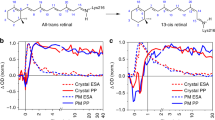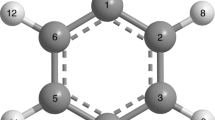Abstract
Real-time investigations of the rearrangement of bonds during chemical transformations require femtosecond temporal resolution, so that the atomic vibrations within the reacting molecules can be observed. Following the development of lasers capable of emitting ultrashort laser flashes on this timescale, chemical reactions involving relatively simple molecules have been monitored in detail, revealing the transient existence of intermediate species as reactants are transformed into products1,2,3. Here we report the direct observation of nuclear motion in a complex biological system, the retinal chromophore of bacteriorhodopsin (bR568)4, as it undergoes the trans–cis photoisomerization that is fundamental to the vision process. By using visible-light pulses of less than 5 femtosecond in duration5,6, we are able to monitor changes in the vibrational spectra of the transition state and thus show that despite photoexcitation of the anti-bonding molecular orbital involved, isomerization does not occur instantly, but involves transient formation of a so-called ‘tumbling state’. Our observations thus agree with growing experimental7,8,9,10,11,12,13,14 and ab initio evidence15,16 for a three-state photoisomerization model8,9,10,17 and firmly discount the initially suggested two-state model18,19,20 for this process.
This is a preview of subscription content, access via your institution
Access options
Subscribe to this journal
Receive 51 print issues and online access
$199.00 per year
only $3.90 per issue
Buy this article
- Purchase on Springer Link
- Instant access to full article PDF
Prices may be subject to local taxes which are calculated during checkout





Similar content being viewed by others
References
Polanyi, J. C. & Zewail, A. H. Direct observation of the transition state. Acc. Chem. Res. 28, 119–132 (1995).
Rose, T. S., Rosker, M. J. & Zewail, A. H. Femtosecond real-time observation of wave packet oscillations (resonance) in dissociation reactions. J. Chem. Phys. 88, 6672–6673 (1988).
Rose, T. S., Rosker, M. J. & Zewail, A. H. Femtosecond real-time probing of reactions. IV. The reactions of alkali halides. J. Chem. Phys. 91, 7415–7436 (1989).
Oesterhelt, D. & Stoeckenius, W. in Methods of Enzymology, Biomembranes Part A, Vol. 31 (eds Freischer, S. and Packer, L.) 667–678 (Academic, New York, 1974).
Shirakawa, A., Sakane, I. & Kobayashi, T. Pulse-front-matched optical parametric amplification for sub-10-fs pulse generation tunable in the visible and near infrared. Opt. Lett. 23, 1292–1294 (1998).
Shirakawa, A., Sakane, I., Takasaka, M. & Kobayashi, T. Sub-5-fs visible pulse generation by pulse-front-matched noncollinear optical parametric amplification. Appl. Phys. Lett. 74, 2268–2270 (1999).
Atkinson, G. H., Ujj, L. &. & Zhou, Y. Vibrational spectrum of the J-625 intermediate in the room temperature bacteriorhodopsin photocycle. J. Phys. Chem. A 104, 4130–4139 (2000).
Hasson, K. C., Gai, F. & Anfinrud, P. A. The photoisomerization of retinal in bacteriorhodopsin: experimental evidence for a three-state model. Proc. Natl Acad. Sci. USA 93, 15124–15129 (1996).
Haran, G. et al. Excited state dynamics of bacteriorhodopsin revealed by transient stimulated emission spectra. Chem. Phys. Lett. 261, 389–395 (1996).
Gai, F., Hasson, K. C., McDonald, J. C. & Anfinrud, P. A. Chemical dynamics in proteins: the photoisomerization of retinal in bacteriorhodopsin. Science 279, 1886–1891 (1998).
Humphrey, W., Lu, H., Logonov, I., Werner, H.-J. & Schulten, K. Three electronic state model of the primary phototransformation of bacteriorhodopsin. Biophys. J. 75, 1689–1699 (1998).
Zhong, Q., Ruhman, S. & Ottolenghi, M. Reexamining the primary light-induced events in bacteriorhodopsin using a synthetic C13 = C14-locked chromophore. J. Am. Chem. Soc. 118, 12828–11829 (1996).
Ye, T. et al. On the nature of the primary light-induced events in bacteriorhodopsin: ultrafast spectroscopy of native and C13 = C14 locked pigments. J. Phys. Chem. B 103, 5122–5130 (1999).
Song, L. & El-Sayed, M. A. Primary step in bacteriorhodopsin photosynthesis: bond stretch rather than angle twist of its retinal excited-state structure. J. Am. Chem. Soc. 120, 8889–8890 (1998).
Vreven, T. et al. Ab initio photoisomerization dynamics of a simple retinal chromophore model. J. Am. Chem. Soc. 119, 12687–12688 (1997).
Garavelli, M., Negri, F. & Olivucci, M. Initial excited-state relaxation of the isolated 11-cis protonated Schiff base of retinal: Evidence for in-plane motion from ab initio quantum chemical simulation of the resonance Raman spectrum. J. Am. Chem. Soc. 121, 1023–1029 (1999).
Du, M. & Fleming, G. R. Femtosecond time resolved fluorescence spectroscopy of bacteriorhodopsin: direct observation of excited state dynamics in the primary step of the proton pump cycle. Biophys. Chem. 48, 101–111 (1993).
Peteanu, L. A., Shoenlein, R. W., Wang, Q., Mathies, R. A. & Shank, C. V. The first step in vision occurs in femtoseconds: complete blue and red spectral studies. Proc. Natl Acad. Sci. USA 90, 11762–11766 (1993).
Shoenlein, R. W., Peteanu, L. A., Wang, Q., Mathies, R. A. & Shank, C. V. Femtosecond dynamics of cis-trans isomerization in a visual pigment analog: isorhodopsin. J. Phys. Chem. 97, 12087–12092 (1993).
Mathies, R. A., Brito Cruz, C. H., Pollard, W. T. & Shank, C. V. Direct observation of the femtosecond excited-state cis-trans isomerization in bacteriorhodopsin. Science 240, 777–779 (1988).
Atkinson, G. H., Brack, T. L., Blanchard, D. & Rumbles, G. Picosecond time-resolved resonance Raman spectroscopy of the initial trans to cis isomerization in the bacteriorhodopsin photocycle. Chem. Phys. 131, 1–15 (1989).
van den Berg, R., Jang, D. J., Bitting, H. C. & El-Sayed, M. A. Subpicosecond resonance Raman spectra of the early intermediates in the photocycle of bacteriorhodopsin. Biophys. J. 58, 135–141 (1990).
Doig, S. J., Reid, P. J. & Mathies, R. A. Picosecond time-resolved resonance Raman spectroscopy of bacteriorhodopsin J, K, and KL intermediates. J. Phys. Chem. 95, 6372–6379 (1991).
Diller, R. et al. Femtosecond time-resolved infrared laser study of the J-K transition of bacteriorhodopsin. Chem. Phys. Lett. 241, 109–115 (1995).
Pollard, W. T. et al. Theory of dynamic absorption spectroscopy of nonstationary states. 4. Application to 12-fs resonant impulsive Raman spectroscopy of bacteriorhodopsin. J. Phys. Chem. 96, 6147–6158 (1992).
Bardeen, C. J., Wang, Q. & Shank, C. V. Femtosecond chirped pulse excitation of vibrational wave packets in LD690 and bacteriorhodopsin. J. Phys. Chem. A 102, 2759–2766 (1998).
Eyring, G., Curry, B., Broek, A., Lugtenburg, J. & Mathies, R. Assignment and interpretation of hydrogen out-of-plane vibrations in the resonance Raman spectra of rhodopsin and bathorhodopsin. Biochemistry 21, 384–393 (1982).
Myers, A. B., Harris, R. A. & Mathies, R. A. Resonance Raman excitation profiles of bacteriorhodopsin. J. Chem. Phys. 79, 603–613 (1983).
Kobayashi, T., Shirakawa, A., Matsuzawa, H. & Nakanishi, H. Real-time vibrational mode-coupling associated with ultrafast geometrical relaxation in polydiacetylene induced by sub-5-fs pulses. Chem. Phys. Lett. 321, 385–393 (2000).
Kobayashi, T. & Shirakawa, A. Tunable visible and near-infrared pulse generator in a 5 fs regime. Appl. Phys. B 70, S239–S246 (2000).
Acknowledgements
We thank J. Watson and M. Murao for careful reading of the manuscript. This work was partially supported by the Research for the Future program run by the Japan Society for Promotion of Science (T.K.), the Special Coordination Funds (“Molecular Sensors for Aero-Thermodynamic Research”; H.O.) and Scientific Research (H.O.) of the Ministry of Education, Culture, Sports, Science and Technology.
Author information
Authors and Affiliations
Corresponding author
Rights and permissions
About this article
Cite this article
Kobayashi, T., Saito, T. & Ohtani, H. Real-time spectroscopy of transition states in bacteriorhodopsin during retinal isomerization. Nature 414, 531–534 (2001). https://doi.org/10.1038/35107042
Received:
Accepted:
Issue Date:
DOI: https://doi.org/10.1038/35107042
This article is cited by
-
Formation of thioglucoside single crystals by coherent molecular vibrational excitation using a 10-fs laser pulse
Communications Chemistry (2020)
-
Tunable photocycle kinetics of a hybrid bacteriorhodopsin/quantum dot system
Nano Research (2019)
-
Three-dimensional view of ultrafast dynamics in photoexcited bacteriorhodopsin
Nature Communications (2019)
-
Conical-intersection dynamics and ground-state chemistry probed by extreme-ultraviolet time-resolved photoelectron spectroscopy
Nature Communications (2018)
-
Coherent control of an opsin in living brain tissue
Nature Physics (2017)
Comments
By submitting a comment you agree to abide by our Terms and Community Guidelines. If you find something abusive or that does not comply with our terms or guidelines please flag it as inappropriate.



